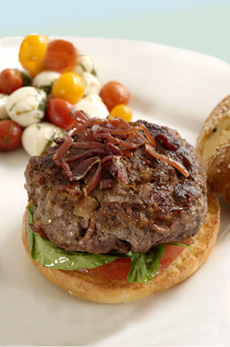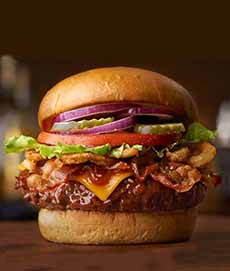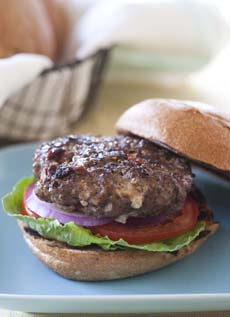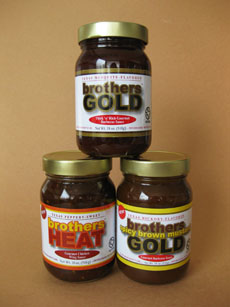|

[1] One of our favorite burgers, from Built Burger.

[2] Another fave: a bacon cheeseburger with onion rings (photo © Smokey Bones).
|
|
National Hamburger Month is May, but that’s not all. National/International Hamburger Day is May 28th, National Burger Day is the Thursday before Labor Day and National Cheeseburger Day is September 18th. How about some hamburger history?
Americans love burgers, consuming nearly 50 billion burgers each year. If you do the math, there are approximately 325,000,000 people in the U.S., which means that the average American consumes 154 burgers a year, or 3 burgers per week.
How did this all begin?
THE FIRST BURGERS
According to a 2022 post in Quora, the famous Roman cookbook De re De Re Coquinaria ((On the Subject of Cooking), known as the first extant cookbook and published in the 4th or 5th century C.E., there was a burger-type patty in ancient Rome.
The recipe is called Isicia Omentata, and consists of minced meat, pepper, wine, and pine nuts, served with Romans’ favorite condiment, a fermented fish sauce called garum. “All ingredients should be mixed together and shaped into a patty,” says the recipe [source].
When we first wrote this article in 2011, the earliest known hamburger aficionados were the Russian Tartars, nomadic groups who joined Genghis Khan’s army in the early 13th century.
They shredded the tougher cuts of beef and ate them without cooking, an early version of the dish we call Steak Tartare (although it should be Steak Tatare—they were Tatars, not Tartars). They introduced the dish to Germany before the 14th century.
We can thank German immigrants for bringing over what became the quintessential American food: the hamburger, or burger for short. (They brought the the frankfurter, too.)
The Germans added spices, and the dish, served both cooked and raw, became popular among people of limited means.
In Hamburg, it became known as “Hamburg steak.” When it arrived in the U.S. during the 1880s wave of German immigration, it became a “hamburger steak” and finally, a “hamburger.”
The original recipe—chopped beef mixed with onions and pepper—appeared on American menus as far back as 1836.
However, the term “hamburger steak” first appeared in print in a Washington State newspaper in 1889.
|
THE SALISBURY STEAK & THE HAMBURGER ROLL
The hamburger also traveled to England, where Dr. J. H. Salisbury, a hearty beef eater, championed the shredding of all foods to improve digestibility (see Salisbury steak).
As with the frankfurter—a sausage in a roll—, it took good old American ingenuity to wrap the bread around a beef patty.
The date of the burger-in-a-roll (the difference between rolls and buns) is not known for certain, although by the 1904 World’s Fair in St. Louis, the hamburger was already a sandwich.
Louis’ Lunch in New Haven claims to have served up the original burger in the U.S. in 1900, putting a beef patty, tomato, onion, and cheese between two slices of toasted white bread—no ketchup or mustard. They still serve it the same way.
Several other American towns lay claim to this watershed in American cuisine. One of them is Seymour, Wisconsin, which claims that in 1885, one Charlie Nagreen was having trouble selling his meatballs at the Seymour Fair—it was hard for people to eat them as they walked around. So Nagreen flattened the ball of meat and placed the patty between two pieces of bread.
That same year, the Menches brothers, who sold sausage patty sandwiches, ran out of pork at the Erie County Fair in Hamburg, New York. Their butcher suggested that they use beef, and they christened the product the Hamburg sandwich.
Tips to make a better burger.
40 different burger recipes.
CHECK OUT WHAT’S HAPPENING ON OUR HOME PAGE, THENIBBLE.COM.
|





